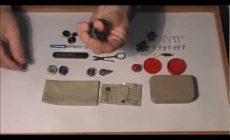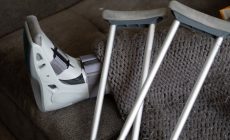Fishing is a very important survival skill to learn as you may be forced to forage for food in order to survive. Survival fishing may be difficult to learn but you can start by learning these important facts:
- There’s nothing “sporting” about survival fishing. Use any method at your disposal, but only in a true survival situation.
- Improvise; use any available material to create the fishing tackle you need.
- If possible, have a number of fish-catching devices in use all the time, preferably while you attend to more important concerns.
- Don’t overlook the possibility of catching smaller fish, which are usually more abundant and more easily caught.
Improvising Hooks, Line and Lures
When in a survival situation it is important to improvised from any material and be resourceful in order to survive and be productive. Fishing hooks can be improvised from any materials like nails, safety pins, paper clips, needles, claw, bird wish bone, soda can tab, and a metal cut from a can. Fishing Gadget recently has published a post on how to make fly-fishing lures at home, go check it to learn more. One thing to remember when surviving is not to overlook any possibility. And if you are on a small boat with limited space, consider getting a rod organizer set up.
- Improvising Hooks
Creating fish hooks in the traditional shape from bone, shells, or wood is also possible if you have a knife. Another type of hook that is more simple and easier to make is the toggle or gorge hook. This is made by using a 1 inch or less straight piece of hard material which can be wood, bone, or antler. Both ends should be sharpened and slightly notched in the middle to attach the line. It is then hidden inside soft bait and when a fish swallows the bait the fisherman pulls the line turning the gorge sideways lodging it in the fish’s throat.
- Improvised Lines
Fishing lines can be made from any materials like threads in clothing and equipment, dental floss, pieces of wire, twisted bark, or sinew from the leg of a deer as long as you know how to improvise fishing lines are not hard to procure.
- Lures
Lures on the other hand can be made feathers, pieces of cloth, and bits of bright metals or earrings that are shaped to imitate natural food like insect or minnow. When fishing in clear waters a strip of colored cloth attached to a hook can be a good lure.
Your improvised fishing gear can be used either as a hard line or with a make shift pole. Set lines can also be created from your extra improvised gear which you can use to fish when you are away. You can attach your lines to a stake driven to the ground or a springy branch hanging over the water.
Using bobby poles are also a good way to fish while you are doing something important. Bobby poles are straight canes or willow shoots that are pushed into the bank. Make sure they are cut long enough to reach well out of the water when driven into the mud with an angle. You can then add a line and hook bait it and drop it in the water. Check as often as possible so you can get your catch and re bait the bobby. Watch this video tutorial on how to fish using a spring pole:
Improvised Spears for Fishing
Creating a makeshift spear for fishing is very easy. You can use metal, wood, or a sharp piece of bone with a whittled sharp end or barbed point. This type of spears is very useful when used with a torch at night while wading shallows.
Another way to capture fish efficiently is by using a jawed spear. You can make this by splitting one end of a long green willow pole or other sapling from 6 – 8 inches on one end. On each flat side in the split you can start carving sharp, rear angles. Tie it down with a cord to bind the split’s upper end stopping it from splitting further. You can then use this by opening the jaws and putting a twig strong enough to separate them by 2 to 3 inches. Once you thrust the spear down over a fish the twig snaps and the jaws snap shut capturing the fish.
Spear fishing has a great advantage because you can select a larger fish to catch compared to using hook and line where your catch is random. Like any other important skills you need a lot of practice and patience to master the skill of spear fishing. Checkout this video on survival spear fishing:
http://www.youtube.com/watch?v=JUlhwoybo1s
Weirs
A weir is designed to catch fish in tidal rivers or waters. This is made by using stakes that are longer than the water is deep and are then driven side by side into the bottom of shallow water which are then used as rectangular fence with three sides. Keep the fences open end on the downstream or down current side. You will then create a V shape wall by driving more stakes. It should point into the open end of the rectangle to funnel the fish into the weir. Such a trap also can be constructed of rocks placed in similar fashion. Fish that are trapped inside can be caught by hand or speared.
Depending on the available materials and the size of the water you can create bigger traps. Small weir traps are very effective as well. The best type of weir traps is the ones that have sidewalls that extend to the bank which allows fewer fish to pass. In muddy water, try herding fish into a trap, starting downstream and driving the fish in front of you. Check this video on weir fishing:
Hand Fishing (Noodling)
Hand fishing is done by finding undercut banks, hollow logs, dark recesses, and beneath rocks in shallow water and catch the fish inside by hand. This is advisable only when the weather is not cold. This is an excellent way to catch suckers and cat fish by blocking the hole so the fish won’t shoot out and reaching inside you move your hands along the fish’s side until you can grasp their mouths or gills. You also can spear fish in holes, or catch them with a stout hook attached directly to the end of a pole. Watch this short video on proper hand fishing techniques:



















2 Comments
Character Talents and Skills: Fishing – WRITERS HELPING WRITERS®
September 18, 2017 - 6:42 pm[…] How to Fish Without Equipment […]
How to catch a fish without equipment - Taunt On Water
March 11, 2022 - 12:56 am[…] Survival Fishing: Best Ways To Catch Fish Without … […]